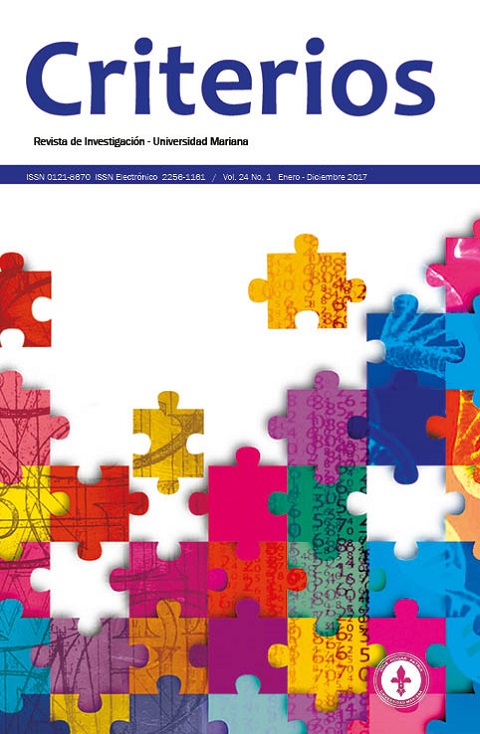Teacher training and the gender relationship in the use and appropriation of ICT
Keywords:
teacher competences, teacher training, information technologies, classification by genderAbstract
To establish the use and appropriation of ICT in the competences of primary and secondary school teachers, a questionnaire of closed reagents was applied to a sample of 100 teachers from the municipality of Soacha, Cundinamarca, Colombia in 2016. Six questions from the survey were analyzed, related to a training workshop and six research hypotheses were studied. The information was processed with the statistical package SPSS v.23, with a Chi square test for the hypotheses. When calculating the C Contingency Coefficient of 0.087 we conclude that this is a low relation; it was shown that there is no relationship between the sex of teachers and the content seen in the Colombia learn portal, PHET laboratories, resource bank, motivation to implement digital resources, tenure and proper use of tablets.
Referencias
Acuña, E. (2005). Análisis de Datos Categóricos. Departamento de Matemáticas Universidad de Puerto Rico- Mayagüez. Recuperado de http://castle.uprm.edu/miniman8sl.pdf
DÃaz, J. (2016). Aplicación PhET: estrategia de enseñanza aprendizaje de fracciones equivalentes. Revista Criterios, 23(1), 111-123.
_____. (2017a). Conocimiento y apropiación de las tecnologÃas de la información y la comunicación (TIC) en la formación docente. Revista Actualidades Pedagógicas, (69), 121-131. Recuperado de https://revistas.lasalle.edu.co/index.php/ap/article/view/4066/3198
_____. (2017b). Importancia de la simulación Phet en la enseñanza y aprendizaje de fracciones equivalentes. Revista Educación y Desarrollo Social, 11(1), 48-63.
Espinosa, H., Restrepo, L. y Aránzazu, D. (2016). Desarrollo de habilidades digitales docentes para implementar ambientes virtuales de aprendizaje en la docencia universitaria. Revista Sophia, 12(2), 261-271.
Khan, S. (2012). Integration of ICT Component in Teacher Educational Institutions: An Unavoidable Step towards Transforming the Quality of Present Teacher Education System. Indian Streams Research Journal, 1(5).
Lind, D., Marchal, W. y Mason, R. (2015). EstadÃstica para administración y economÃa (11ava. ed.). Colombia: Alfaomega.
Organización de las Naciones Unidas para la Educación, la Ciencia y la Cultura (UNESCO). (2000). Foro Mundial sobre la Educación, Dakar 2000. Paris: UNESCO.
Peeraer, J. y Van Petegem, P. (2011). How to Address Integration of ICT in Teaching Practice? Research on Factors Influencing the Use of ICT in Education. Education in a technological world: communicating current and emerging research and technological efforts, 237-244. Recuperado de http://www.formatex.info/ict/book/237-244.pdf
Ryymin, E., Palonen, T. y Hakkarainen, K. (2008). Networking Relations of Using ICT within a Teacher Community. Computers & Education, 51(3), 1264-1282.
Umoru, T. (2012). Barriers to the Use of Information and Communication Technologies in Teaching and Learning Business Education. American Journal of Business Education (Online), 5(5), 575-580.
Webster, A. (2001). EstadÃstica aplicada a los negocios y la economÃa (3ra. ed.). Bogotá, Colombia: McGraw-Hill.
Author Biography
Jorge Enrique Díaz Pinzón, Institución Educativa General Santander
Magíster en Gestión de la Tecnología Educativa; Especialista en Administración de la Informática
Educativa; Ingeniero Agrónomo. Docente titular de Matemáticas de la Institución Educativa General
Santander, Soacha, Cundinamarca, Colombia.
References
Acuña, E. (2005). Análisis de Datos Categóricos. Departamento de Matemáticas Universidad de Puerto Rico- Mayagüez. Recuperado de http://castle.uprm.edu/miniman8sl.pdf
Díaz, J. (2016). Aplicación PhET: estrategia de enseñanza aprendizaje de fracciones equivalentes. Revista Criterios, 23(1), 111-123. https://doi.org/10.19052/ap.4066
Díaz, J.(2017a). Conocimiento y apropiación de las tecnologías de la información y la comunicación (TIC) en la formación docente. Revista Actualidades Pedagógicas, (69), 121-131. https://doi.org/10.18359/reds.2011
Díaz, J.(2017b). Importancia de la simulación Phet en la enseñanza y aprendizaje de fracciones equivalentes. Revista Educación y Desarrollo Social, 11(1), 48-63.
Espinosa, H., Restrepo, L. y Aránzazu, D. (2016). Desarrollo de habilidades digitales docentes para implementar ambientes virtuales de aprendizaje en la docencia universitaria. Revista Sophia, 12(2), 261-271. https://doi.org/10.18634/sophiaj.12v.2i.561
Khan, S. (2012). Integration of ICT Component in Teacher Educational Institutions: An Unavoidable Step towards Transforming the Quality of Present Teacher Education System. Indian Streams Research Journal, 1(5).
Lind, D., Marchal, W. y Mason, R. (2015). Estadística para administración y economía (11ava. ed.). Colombia: Alfaomega.
Organización de las Naciones Unidas para la Educación, la Ciencia y la Cultura (UNESCO).(2000). Foro Mundial sobre la Educación, Dakar 2000. Paris: UNESCO.
Peeraer, J. y Van Petegem, P. (2011). How to Address Integration of ICT in Teaching Practice? Research on Factors Influencing the Use of ICT in Education. Education in a technological world: communicating current and emerging research and technological efforts, 237-244. Recuperado de http://www.formatex.info/ict/book/237-244.pdf
Ryymin, E., Palonen, T. y Hakkarainen, K. (2008). Networking Relations of Using ICT within a Teacher Community. Computers & Education, 51(3), 1264-1282. https://doi.org/10.1016/j.compedu.2007.12.001
Umoru, T. (2012). Barriers to the Use of Information and Communication Technologies in Teaching and Learning Business Education. American Journal of Business Education (Online), 5(5), 575-580. https://doi.org/10.19030/ajbe.v5i5.7214
Webster, A. (2001). Estadística aplicada a los negocios y la economía (3ra. ed.). Bogotá, Colombia: McGraw-Hill.
How to Cite
Downloads
Downloads
Published
Issue
Section
License

This work is licensed under a Creative Commons Attribution 4.0 International License.
Revista Criterios es publicada por la Editorial UNIMAR de la Universidad Mariana bajo los términos de la licencia Creative Commons Reconocimiento 4.0 Internacional (CC BY 4.0)

Altmetric
| Article metrics | |
|---|---|
| Abstract views | |
| Galley vies | |
| PDF Views | |
| HTML views | |
| Other views | |




